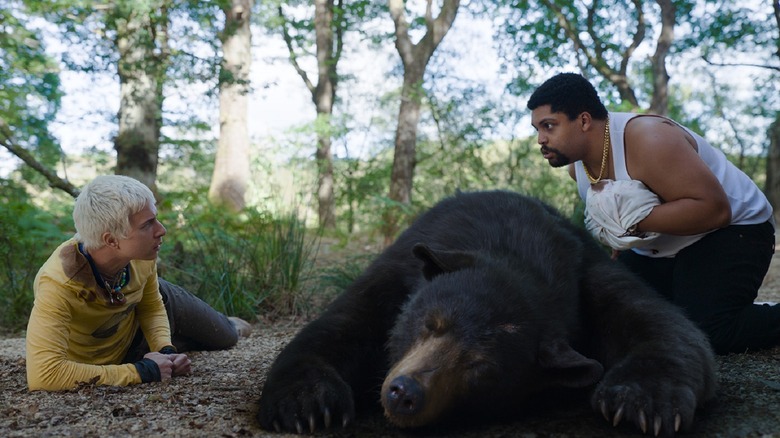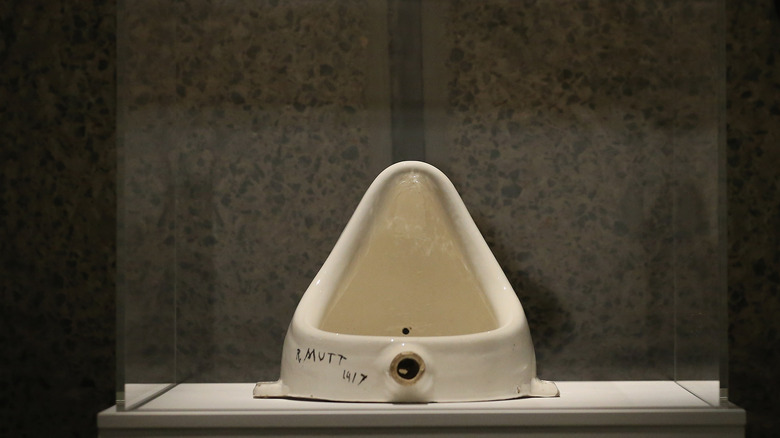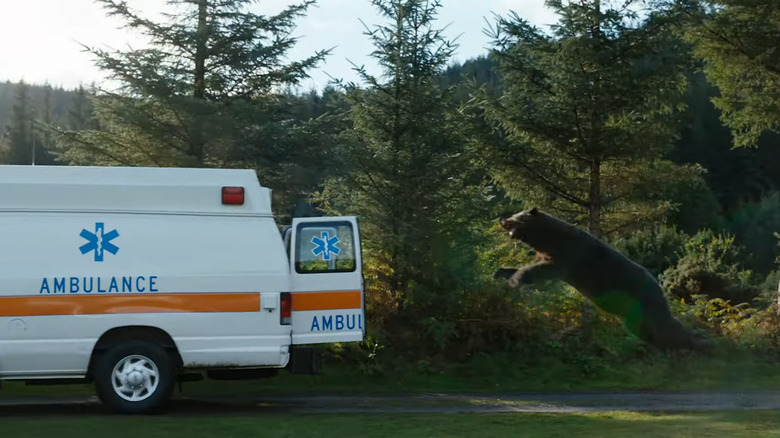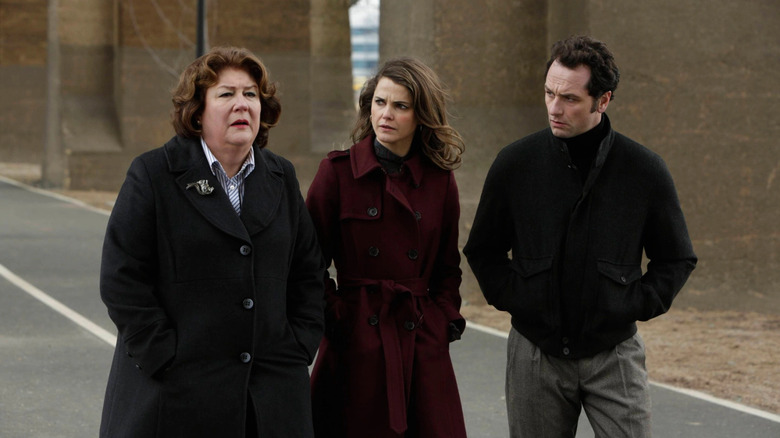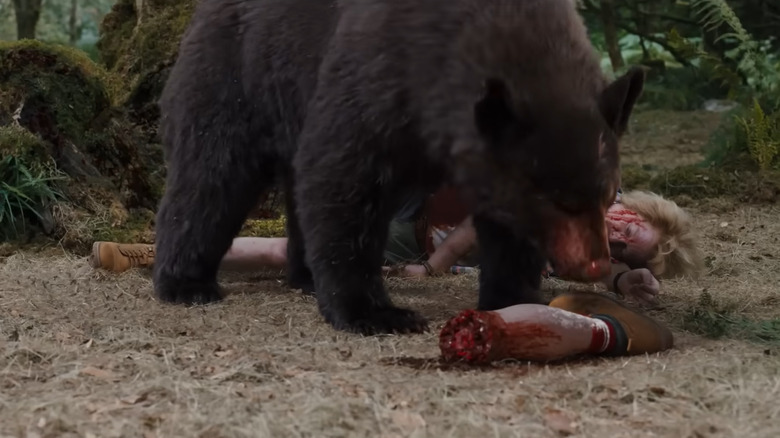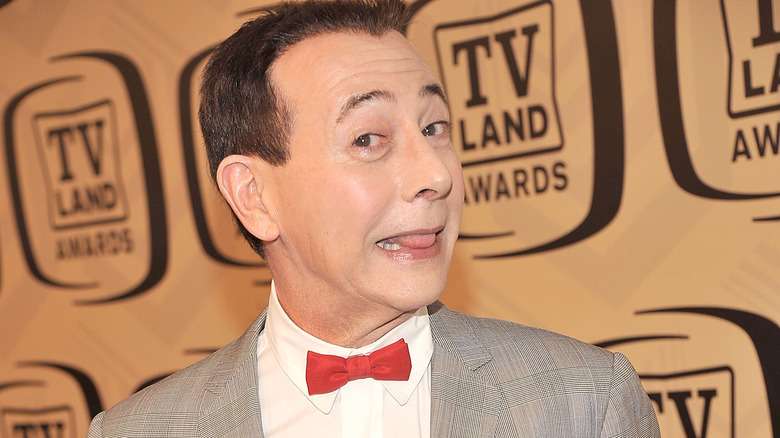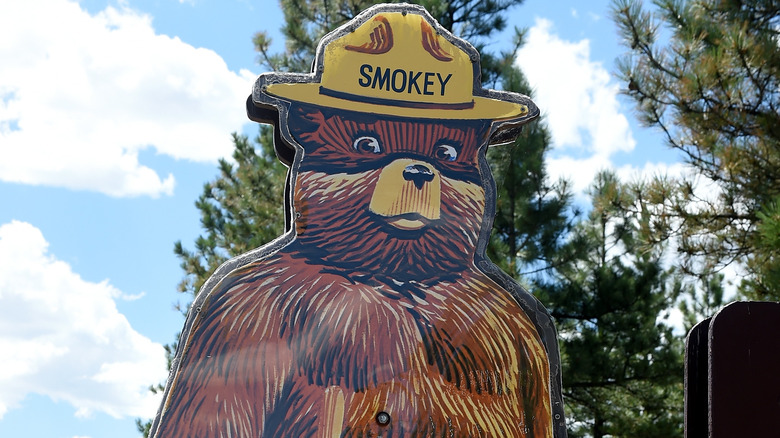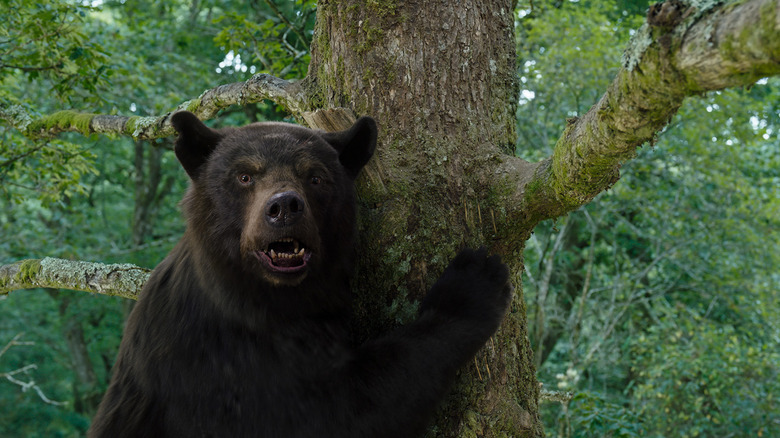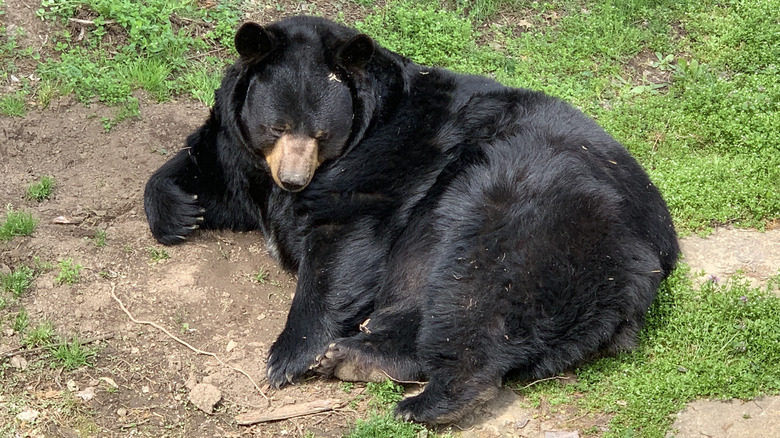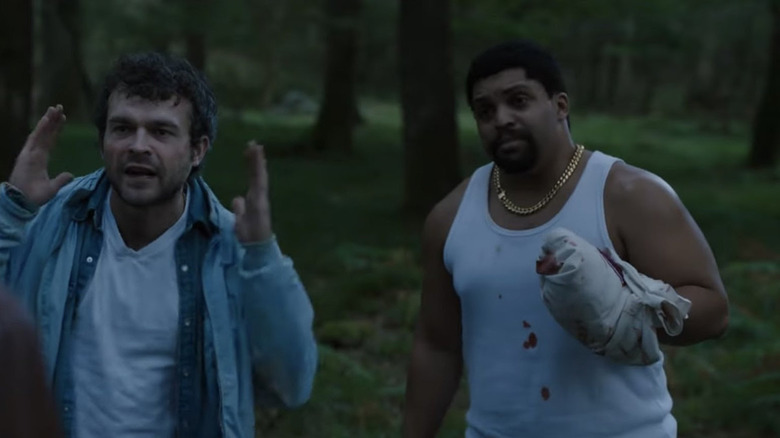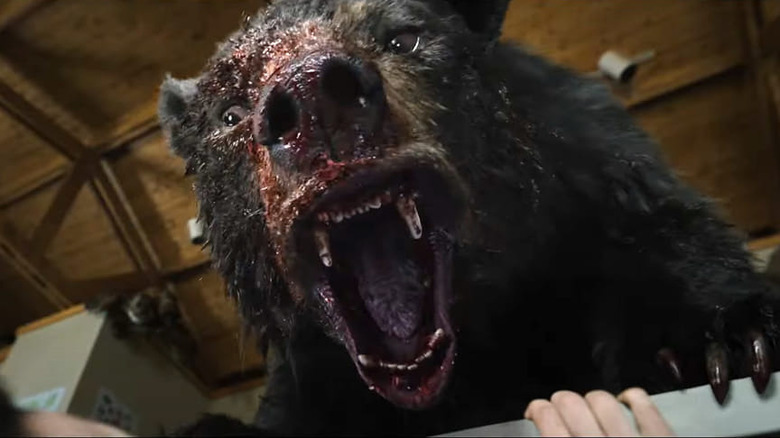Small Details You Missed In Cocaine Bear
"Small" is not a word one would use to describe the 500-pound ursine star of "Cocaine Bear" — the new horror-comedy from director Elizabeth Banks and screenwriter Jimmy Warden that is very loosely inspired by true events. It's also not a word one can really apply to the movie itself. It's exactly the ultra-violent, in-your-face, and subtlety-free movie you would expect based on the title. Comedian and TikTok star Scott Seiss — who also has a small role in the film — put it well in a tongue-in-cheek TikTok video about "what you need to know before you see Cocaine Bear." A question he answers decisively by saying, "Nothing! You don't need to read a comic book from 1978. The bear wasn't introduced at the end of 'The Eternals.' If you've ever heard the words 'cocaine' or 'bear' before, you're completely up to speed."
The thrills and laughs in "Cocaine Bear" are hard to miss, easy to get, and — depending on your state of mind and general taste for camp absurdity — very entertaining. However, even though subtlety is not a word in this film's lexicon, there are a handful of gags that will be enhanced with a little bit of background knowledge. There's not much the average viewer should miss in "Cocaine Bear," but this list will attempt to explain every detail that could theoretically pass you by. Beware, spoilers lie ahead.
The Duchamps gang
Here it is, the one joke in "Cocaine Bear" that will put art history degrees to use. Stache (Aaron Holliday), Ponytail (Leo Hanna), and Vest (J.B. Moore) are a trio of teenage troublemakers who get caught up in the cocaine mess and are known as the Duchamps gang. The group's namesake, Marcel Duchamp, was a troublemaker of a very different sort in the art world.
Duchamp was a French artist working in the early 20th century with ties to the Cubist, Surrealist, and Dadaist movements. The latter movement — which rejected logic and reason in response to the horrors of World War I — is arguably the most relevant to "Cocaine Bear" as a work of cinematic art. Duchamp's most famous and controversial piece of Dadaist art was a 1917 "readymade" sculpture installation titled "The Fountain," which consisted of a urinal signed "R. Mutt." Yes, even the most highbrow reference in "Cocaine Bear" still circles back around to a toilet.
The glory hole billboard
With experience directing, writing, and producing films such as "The LEGO Movie," "Spider-Man: Into the Spider-Verse," and "The Mitchells vs. The Machines," Phil Lord and Chris Miller have mastered the art of making movies so packed to the brim with background gags that you have to watch them multiple times to process all of the humor. "Cocaine Bear" has fewer opportunities for such gags than other Lord and Miller productions — given that it takes place mostly in the woods — however, they still manage to sneak a few things in there.
One particular background gag stands out: a billboard on the side of the road, seen towards the beginning of the film, advertising "The Original Glory Hole." This is in fact one of the more realistic details in the movie — the "Glory Hole" is a real tourist attraction in the North Georgia Mountains that used to be a gold mining site in the 1880s. Of course, when the viewers of an R-rated comedy read about "glory holes," they're not thinking about gold mining but rather something a lot cruder, so this background double-entendre fits perfectly with the film's general sophomoric sense of humor.
The Americans reunion
"Cocaine Bear" is a particularly strange experience for fans of "The Americans" — the critically-acclaimed FX drama about Soviet spies living undercover as a married couple in the United States. These are two very different depictions of life in the '80s, but they do share three actors. Keri Russell and Matthew Rhys, who played the lead spy couple of Elizabeth and Philip Jennings in "The Americans," and character actress Margo Martindale, who won two Emmys for playing the spies' handler, Claudia.
Russell has the biggest role of the three in "Cocaine Bear," playing the heroic nurse Sari. Martindale plays the park ranger Liz, who gets injured by the bear and then killed while in an ambulance for her previous injuries. Rhys has the smallest role of the three, essentially a glorified cameo in the opening scene, but he has the unusual distinction of playing the only character directly based on a real person — the drug smuggler Andrew C. Thornton II.
Though there are no direct references to "The Americans" in "Cocaine Bear," however, the choice of one character name feels like an homage to the series. The best friend of Sari's daughter Dee Dee (Brooklynn Prince) is named Henry (Christian Convery) — the same name as the Jennings' son in "The Americans." Hearing Sari repeatedly call out Henry's name throughout the film will definitely bring back memories for fans of "The Americans."
The first death really happened
The resemblance between the "Cocaine Bear" movie and the true story that inspired it is minimal at best. The real cocaine bear died from an overdose and did not attack any human beings, so all of the film version's gory kills are pure imagination and creativity. Given the sheer absurdity, you might not realize that there is one death in the film taken directly from history: that of Andrew C. Thornton II, the smuggler who caused this mess in the first place.
In the opening scene of the film, Thornton is on a plane running drugs from Colombia. Afraid that federal agents are following him, he tosses his product out of the plane before trying to escape himself with a parachute and another bag of cocaine. As he's about to jump, however, he hits his head and falls to his death, with his corpse landing in Knoxville, Tennessee. The death plays as violent slapstick, but this is actually how Thornton died according to the Georgia Bureau of Investigations (via The Independent). Given how wild the true story was, it makes sense that the filmmakers were inspired by it as the basis for their fictionalized version.
The bear is CGI but the gore is practical
It's pretty obvious that the bear in "Cocaine Bear" is not a real bear but rather a computer-animated character. Created by WETA Workshop, this digital creation is responsible for much of the film's $35 million budget, and while convincing enough to work for the purposes of the film, there's a definite sense of cartoonishness to the bear's animation that stops it short of photorealism. What could be overlooked by viewers is just how much work it took to integrate the digital bear with the live-action cast, and how many practical effects are used for depicting the gory aftermaths of the bear's rampages.
Some critics had mixed feelings about the way practical effects and CGI were combined, and some complained about there being too much CGI, but the art of practical gore is being kept alive in this movie. The multiple severed limbs seen throughout the movie are made of rubber with little pumps inside to squirt blood. And some of the planned prosthetics work was actually so graphic that it ended up having to be cut from the finished film (per Entertainment Weekly). Even the CGI was gifted some of the physicality and presence of practical techniques thanks to having stunt performer Allan Henry on set as a human stand-in for the bear.
The anti-drug PSAs explained
Halfway through this list and already we have to start stretching the definitions of "small" and "missed." Unless audience members are somehow dozing off five minutes into the movie, nobody watching "Cocaine Bear" is going to miss the presence of a montage showcasing various "Just Say No" anti-drug ads from the '80s. Those too young to have memories of such ads, however, may wish to have more context for these unintentionally hilarious public service announcements.
The first clip in the montage is the most famous of them all, the "This is your brain on drugs" ad with an egg representing "your brain" and a frying pan representing "drugs." Next up is a PSA where Pee-Wee Herman — the host of the trippy children's show "Pee-Wee's Playhouse" — tries to deliver a very serious warning about the dangers of crack while still talking in his ridiculous character voice. Third in the montage is a clip of Nancy Reagan, the First Lady who spearheaded the "Just Say No" campaign. Last is an ad from the New York City Housing Authority Narcotics Task Force, where a man gives a particularly awkward dramatic delivery of a line comparing crack to gun violence.
Another famous bear makes a cameo
One of the few cultural references you can naturally fit into the background of a national park in the '80s is the mascot of the U.S. Forest Service himself, Smokey the Bear. First created in 1944 and known to multiple generations of Americans through posters and PSAs, Smokey was designed to educate people on fire safety in the great outdoors. His famous slogan for decades was "Only YOU can prevent forest fires!" — later changed to "wildfires" in 2001 to both expand the mission and address ecological criticism.
In "Cocaine Bear," a cardboard cutout of Smokey is seen in Ranger Liz's office — a location that ends up as the setting for some gruesome deaths. Smokey the Bear certainly would not approve of the cocaine bear's antics, but almost inevitably, the production crew decided to nickname their monster protagonist "Cokie the Bear" in a humorous homage to the famous character.
Other '80s cultural references
In contrast to "Stranger Things" and other popular period pieces that try to overdose on '80s nostalgia, "Cocaine Bear" is not concerned with overloading younger viewers with pop culture references. Other than the inclusion of the period-accurate PSA clips, the most noteworthy pop culture references are fairly minor, with Dee Dee having posters of various popular musical artists from the time — including Depeche Mode, Madonna, and Billy Idol — on her bedroom walls. Another notable Easter Egg is a reference to the Pines Mall from "Back to the Future."
The '80s flavor of the film comes through loud and clear in the clothes and hairstyles of the characters. Additionally, the film's focus on drugs and cocaine, in particular, is evocative of the topical issues that defined the era. Even the style of filmmaking evokes '80s slashers, schlocky creature features, and extreme horror-comedies like Sam Raimi's "The Evil Dead" movies. Finally, the logo of the Lord-Miller production company at the start of the film gets a stylized neon makeover to appear as if it came from the '80s — or at least the style through which today's pop culture remembers the '80s.
There are two mid-credits scenes
These two scenes aren't on the list because they're too subtle to notice or too obscure for everyone to get. However, they make the list of moments you might have missed because if you walked out of the theater when the credits started, you will have quite literally missed them. Nick Fury might not be showing up to invite Cocaine Bear into the Avengers Initiative, but there are a couple of mid-credits scenes that find humor in the idea of other animals using and abusing cocaine.
The first mid-credits scene catches up with Stache — the only surviving member of the Duchamps gang — who hitches a ride to the city in a shepherd's truck. And he has to make sure that the sheep do not get access to his bag of cocaine, of course. In the second scene, former drug dealers Eddie (Alden Ehrenreich) and Daveed (O'Shea Jackson Jr.) notice a block of their cocaine is missing, and suspect their newly adopted dog, Rosette, might have eaten it.
Neither of these credits sequences is particularly funny, so you're not missing a ton if you walked out early. And while we'd never want to rule out "Cocaine Sheep" or "Cocaine Dog" as potential sequel ideas, there are plenty — and more interesting — wild animals on drugs true stories for the filmmakers to mine for follow-up features should they choose to.
The home of the real taxidermied bear is thanked
If you sit all the way through the credits of "Cocaine Bear" then you'll notice a certain location being thanked: Kentucky for Kentucky Fun Mall. What does this mall have to do with the movie? Well, it's the home of the remains of the actual cocaine bear, wonderfully nicknamed "Pablo Escobear." If you're in Kentucky, there are far worse things you can spend your time doing than checking out the inspiration for this film.
How did Pablo Escobear end up at this Kentucky mall? Initially, the bear was taxidermied and put up on display at the visitors center in the Chattahoochee River National Recreation Area, but was moved into storage due to a wildfire. A robbery ensued, and the bear was given to a pawn shop where it ended up being purchased by country star Waylon Jennings. Over the years, the bear changed owners from Jennings to Ron Thompson (a friend of Andrew C. Thornton II) to Zhu T'ang (who won it in an auction) to eventually Kentucky for Kentucky Fun Mall in 2015.
It can be read as a cultural metaphor
"Cocaine Bear" is not the sort of film you'd think of as a message movie. What messages it does have — don't mess with the environment, drugs are bad but so was the "war on drugs" — are both obvious in presentation and generally beside the point of why people are going to see it. But what if we told you there was potentially a deeper, more metaphorical layer to the story of a bear on cocaine?
Don't take our word for it, director Elizabeth Banks herself told Vanity Fair at the film's world premiere: "I made this movie during the pandemic when everything seemed scary and traumatic. I felt like there was no greater metaphor for the chaos all around us than a bear who is high on cocaine. So if this helps people process the last two and a half years of their life, I'll feel great about that. I hope they are just entertained."
In a way, this thinking connects back to Marcel Duchamp and Dadaism: If society is simply broken, then even trying to respond with rationality is futile and the more effective response may be to embrace the chaos of, say, a bear on cocaine. Of course, Banks' high-minded explanation could be seen as tongue-in-cheek, but it does touch on the value of making such an utterly ridiculous movie in such dark and scary times.
This movie really isn't trying to hide anything
Well, that's basically it in terms of what you could have missed when watching "Cocaine Bear." And isn't that kind of refreshing in its own way? Sure, there could have been a version of this story that was packed with more jokes that might require explanations, or perhaps a version with more direct horror movie homages that could be called out and identified. Those versions could have been good — maybe better than the one that ended up being made and released in theaters — but there's something to be said about the value of a movie that delivers exactly what it says is going to deliver: no more and no less.
When so often movie trailers can be misleading, "Cocaine Bear" is exactly the movie that's been advertised. It is unashamedly ridiculous, ultra-violent, a mix of silly and scary, and filled with a knowing stupidity that makes for a great time in the cinema. Every major twist and turn will stick in your memory, and it is packed with brilliantly bizarre moments that seem destined to become memes. If you think you would find entertainment in a movie called "Cocaine Bear," then you're going to get exactly what you came for and there's no chance you'll leave feeling disappointed or short-changed.
If you or anyone you know needs help with addiction issues, help is available. Visit the Substance Abuse and Mental Health Services Administration website or contact SAMHSA's National Helpline at 1-800-662-HELP (4357).
